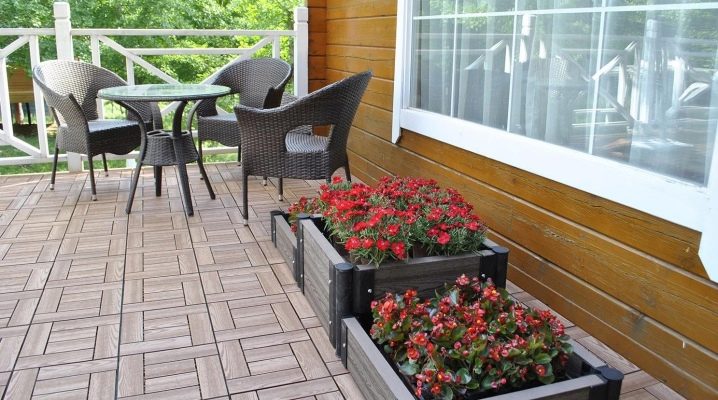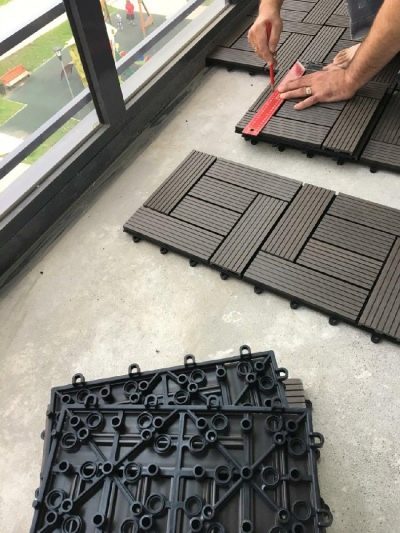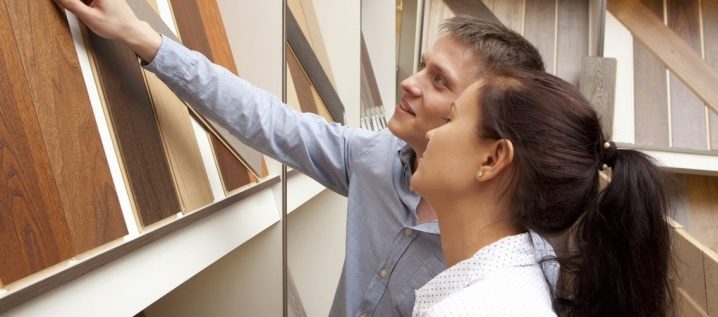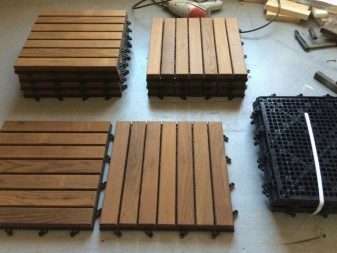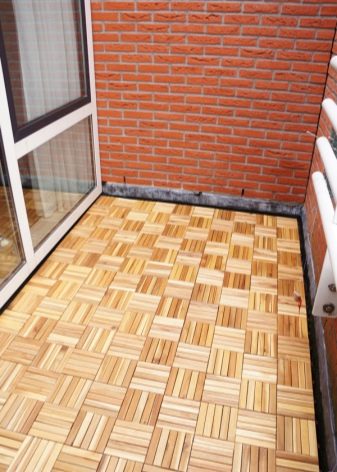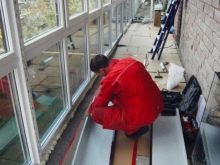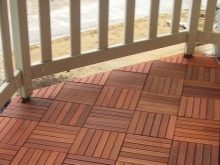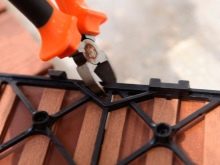Garden parquet for balcony and loggia
Garden parquet replaced concrete tiles and was intended for paving garden paths and open verandas. However, the owners of balconies and loggias quickly appreciated the practicality and aesthetics of the coating and actively began to cover the floors with it.
Peculiarities
Unlike its classic predecessor, garden parquet has completely different performance characteristics and is adapted to use in subzero temperatures. In Europe, it is known as decking, which means «deck covering». The name speaks for itself: the material behaves well in outdoor conditions and endures the influence of aggressive environmental factors. The scope of use of garden parquet is quite wide. They are lined with floors on balconies and open terraces, as well as in baths, saunas, gazebos, along the perimeter of pools.
Decking is available in the form of rectangular or square slabs of various sizes ranging from 30x30 to 90x30 cm. The back of the slab is equipped with a wooden or plastic base. Each element has side fasteners, with the help of which the plates are connected to each other. Thanks to the locking system, the installation of the garden parquet takes a few minutes and can be done by a non-professional.
In addition, the installation does not require preliminary preparation of the base, and the deck can be mounted on bare concrete.
The front side of the garden slab resembles ordinary parquet in its structure. Rectangular planks are arranged in a geometric pattern or simply parallel to each other. There is a small distance between the planks, due to which water does not stagnate inside the coating, but goes into the ground or evaporates. The surface of the parquet is made using the anti-slip technique, which makes it non-slip and slightly rough.
The undoubted advantages of garden parquetry include its hypoallergenicity, presentable appearance and structure that is warm to the touch. The material does not heat up in the sun and is easily cleaned of dirt. The deck, made of composite and plastic, is not subject to decay and has a long service life.
Garden parquet is produced in a wide range, which allows you to choose a covering for every taste and budget.
Views
The classification of garden parquet is made according to such characteristics as the material of the planks and the quality of the substrate. According to the first criterion, wooden, plastic and composite models are distinguished.
Wood parquet
Unlike classic parquet, in the production of garden parquet, special types of wood are used, which many European consumers have never heard of. They are dominated by the South Asian tropical species that grow in conditions of high temperatures and torrential rain showers. For the production of decking, kempasa, merabu, paduka, iroko and azobe wood are used. To avoid decay, wooden models are produced on a plastic base. The advantages of wooden parquet include high decorativeness, the ability to retain heat for a long time and a non-slip surface.
Among the minuses, they note the high cost and the need for insect control when operating in outdoor conditions.
Plastic parquet
Decking made of plastic is the most popular and affordable type of coating. It is much cheaper than its wooden counterpart, environmentally friendly, lightweight and very easy to install. Plastic boards are not interesting for insects and are not susceptible to mold and mildew. Plastic is not prone to deformation, does not cause problems during transportation, and has a long service life. Among the minuses, one can note the limitation in the use of chemical cleaning agents and a somewhat rustic appearance. In addition, plastic does not like direct exposure to ultraviolet rays and fade in the sun.
Wood-polymer composite parquet
The basis of such parquet is sawdust and polymers, which makes it possible to obtain a practical material at an affordable price. The service life of the coating outdoors is 10 to 15 years. The advantages of WPC models include complete environmental friendliness, resistance to putrefactive processes, high strength and anti-slip surface. Moreover, the material is not of interest to insects and perfectly imitates valuable wood species. Parquet is not afraid of temperature extremes and high humidity, does not fade in the sun and can be used on non-glazed balconies.
The second criterion for classifying decking is the type of substrate.
On this basis, parquet is divided into 2 types - soft and hard. The first is produced on a flexible plastic base, the second - on a wooden one.
How to choose?
When choosing a garden parquet for a balcony, it is necessary to take into account the conditions in which it will be used. A glazed balcony is suitable for a covering made of natural wood, and not only from exotic species, but also from quite familiar larch and cedar. If the deck will lie on a cold balcony without glazing, then it is better to purchase a composite covering. You can buy plastic parquet for a rented apartment. It has an affordable price, is very easy to install and does not cause any difficulties during transportation.
How to pack?
It is very easy to install garden parquet and even a person without experience can do it.
- The first step is to measure the area of the balcony and calculate how many slabs are needed for work.
- Furniture and foreign objects are taken out from the balcony. After that, the floor is well swept, washed and allowed to dry.
- Laying the parquet starts from the far corner, connecting the tiles to each other using side locks.
- The tiles of the last row are shortened if necessary. To do this, turn the tile over, cut the plastic substrate with pliers in front of the excess strips and easily separate them from the stove.
- A decorative plinth is laid along the perimeter.
Follow-up care
Plastic and composite decking options do not require special maintenance, they are easy to clean with a brush and ordinary detergent. To prevent burnout, plastic plates are covered with a special compound, but this may only be relevant for French balconies with an open type fence. Coverings made of natural wood are periodically impregnated with compounds against insect pests, however, they do this subject to operation on an unglazed balcony. In closed and heated rooms, there is no point in such processing.
For more details on the application and features of garden parquet, see below.
